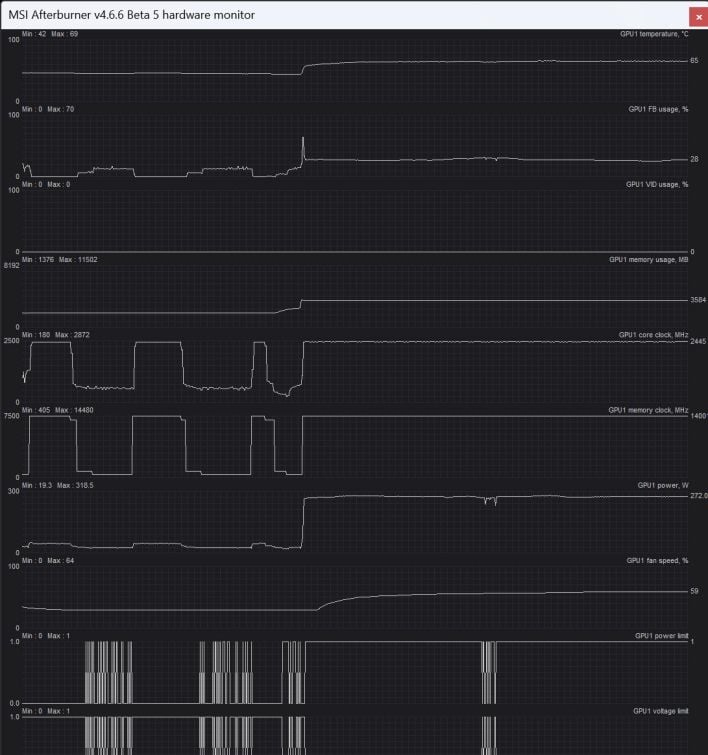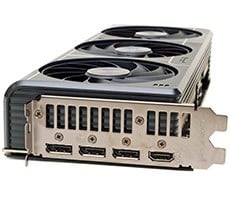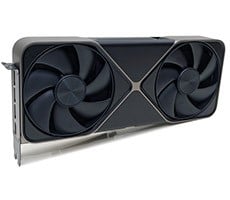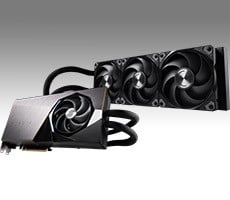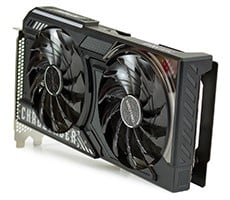ASUS Prime GeForce RTX 5070 Ti Review: Midrange Blackwell Tested
We also spent some time overclocking the ASUS PRIME GeForce RTX 5070 Ti to wring out some additional performance from its GB203 GPU and GDDR7 memory. We had great success overclocking with the RTX 5080 (which is based on the same GPU), and were eager to see what the scaled down RTX 5070 Ti could do...
Overclocking The ASUS PRIME GeForce RTX 5070 Ti
As we've already mentioned in numerous articles at this point, Blackwell-based GeForce RTX 50 series cards feature GPU Boost, which scales frequencies and voltages, power and temperatures permitting, based on the GPU's workload at the time -- just like the last couple of generations. Should a temperature or power limit be reached, GPU Boost will drop down to the previous boost frequency and voltage stepping, in an attempt to bring power and temperatures down gradually and not cause any significant performance swings.
To overclock the cards, the maximum boost clock and power limit can be tweaked to increase performance. Altering the fan speed curve and GPU voltage (when applicable) can allow for further tuning when supported.
Like previous-gen cards, the ASUS PRIME GeForce RTX 5070 Ti is usually voltage or power limited to prevent damage and ensure longevity, and it's those limits that will usually determine your success when overclocking. With the ASUS PRIME GeForce RTX 5070 Ti, the power target can be increased by up to a massive 15%, but the GPU voltage could not be altered, at least not in the latest beta version of MSI's Afterburner we used. That said, we were able to increase the GPU and memory clocks quite a bit over their default values, in addition to cranking up that power limit.
We upped the power target to its maximum (115%) and used the GPU and memory frequency offsets in Afterburner to manually alter the ASUS PRIME GeForce RTX 5070 Ti's frequencies. We increased the GPU and memory clock offsets incrementally until the test system was no longer stable, showed on-screen artifacts, or performance peaked due to hitting a power or other limit.
In its stock configuration, the ASUS PRIME GeForce RTX 5070 Ti hit a 2,445MHz boost clock and peaked at only 65°C, while maintaining its 28Gbps memory data rate (effective 14,000MHz). While overclocked, however, we were able to take its GPU clock all the way up to 2,865MHz with a 29.6Gbps memory speed. That's an over 17% increase in GPU frequency for those keeping count.
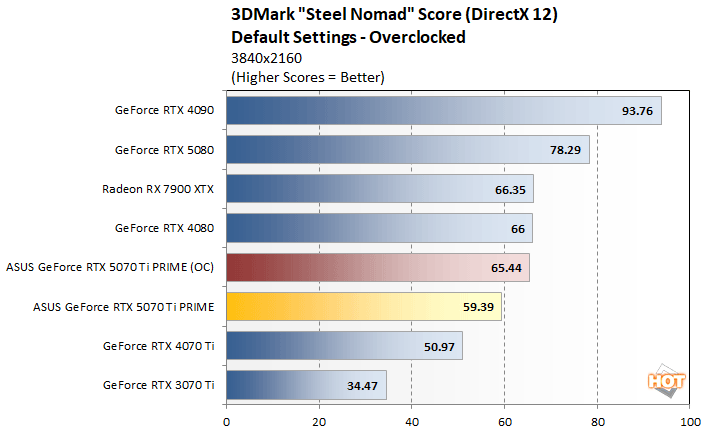
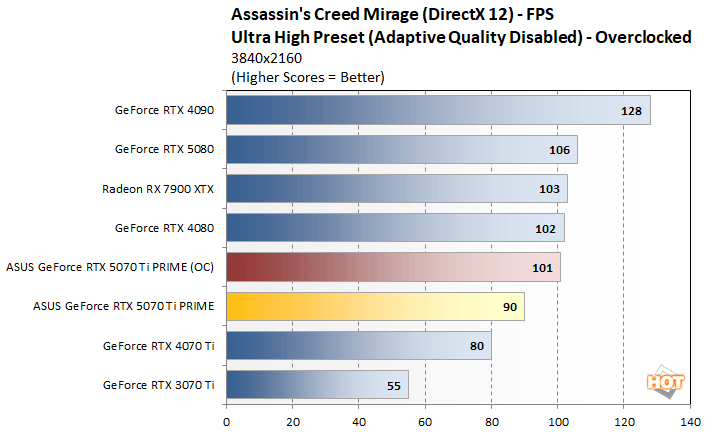
With the ASUS PRIME GeForce RTX 5070 Ti overclocked, we re-ran some tests and saw some really nice performance gains, in the neighborhood of 10% - 13%. Just like the RTX 5080, it appears NVIDIA is being quite conservative with the RTX 5070 Ti's recommended clocks and power limit.
We should also mention, that while overclocked the ASUS PRIME GeForce RTX 5070 Ti remained relatively cool. We saw temperatures peak at 68°C, which was only a couple of degrees higher than stock and the fan speed maxed out at only 64%.
Total System Power Consumption
Throughout all of our benchmarking and testing, we also monitored noise output and tracked how much power the GPUs were consuming in our test system. Our goal here is to give you an idea as to how much power each GPU used while idle and also while under a heavy workload.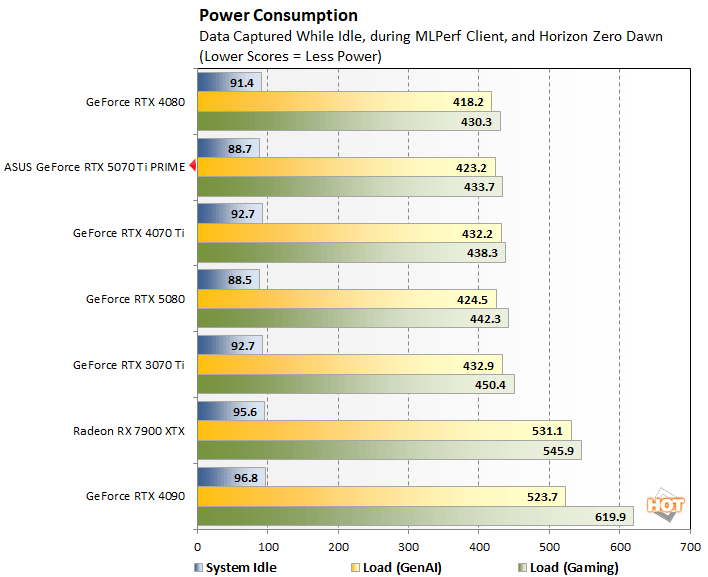
The ASUS PRIME GeForce RTX 5070 Ti's power consumption wasn't much different than its predecessor. The ASUS PRIME GeForce RTX 5070 Ti, RTX 4080 and RTX 4070 Ti were all within a few watts of one another, which bodes well for the RTX 5070 Ti's efficiency -- despite outperforming the RTX 4070 Ti across the board, power use was actually slightly lower, at least with the ASUS boards we used for testing.
Noise is non-issue for the ASUS PRIME GeForce RTX 5070 Ti as well. At idle or when under light loads, the card is effectively silent. It's fans spin down completely when the GPU temperature is below 50°C and don't ramp up until temps surpass 55°C. The card is dead silent at idle or under low loads. When under a heavy, sustained workload, the ASUS PRIME GeForce RTX 5070 Ti's fans do spin up quite a bit, but we would not consider it loud by any means. It is audible, but is relatively tame versus other high-end GPUs.ASUS PRIME GeForce RTX 5070 Ti Review Summary & Conclusions
At this point, we suspect all of your understand NVIDIA’s M.O. with the GeForce RTX 50 series. Traditional rasterization performance was increased over the previous generation, but not to the same extent as past releases. The GeForce RTX 4070 Ti leapfrogged the RTX 3070 Ti with traditional raster, whereas the GeForce RTX 5070 Ti is about +/-30% faster than the RTX 4070 Ti. When its new RTX Neural Rendering features and DLSS 4 multi-frame gen are employed, however, the GeForce RTX 5070 Ti can put up much higher framerates than any previous-gen card – look to our Cyberpunk 2077 benchmarks to see the upside performance that's on tap. Whether you count those generated frames as additional performance is up for debate for some of you, but that fact is, every GPU manufacturer is reaching a point of diminishing returns with traditional rasterization within the limitations of current manufacturing processes, so using AI to generate frames has a much more significant impact on the smoothness of on-screen animation. This topic merits a deeper discussion on its own, and is something all gamers and enthusiasts should ponder.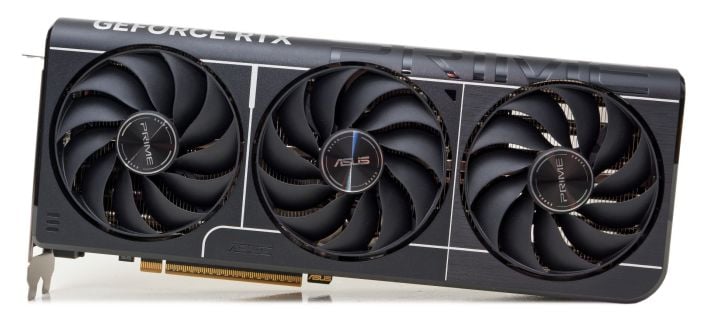
That said, the GeForce RTX 5070 Ti is an upgrade over the previous generation nonetheless. It’s faster across the board in our game tests and AI and creator workloads perform better on it as well. If you’ve got an RTX 40 series card, however, the significance of that upgrade is probably not motivation enough to take the leap. If you’ve got a mainstream RTX 30-series card, however, it’s a different story. The GeForce RTX 5070 Ti is a monster upgrade over the RTX 3070 Ti, not only for its updated GPU architecture but also for its 16GB GDDR7 frame buffer.
At an MSRP of $749, the GeForce RTX 5070 Ti arrives at a $150 higher MSRP than the RTX 3070 Ti, but $50 lower than the RTX 4070 Ti. If you’ve got an older GPU and are contemplating an upgrade, but don’t have a G or more to spend, the GeForce RTX 5070 Ti is worth a look. It’s got a bleeding-edge feature set, it's likely highly tweakable for overclocking, and DLSS 4 with multi-frame gen will only get more pervasive over time. There are some other new GPUs on the horizon though, from both AMD and NVIDIA, so perhaps sit tight for a bit to better understand the entire consumer graphics card landscape before parting with your hard-earned cash.


